The fencers of Welzow
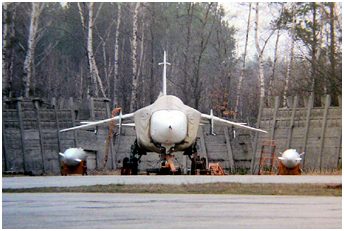
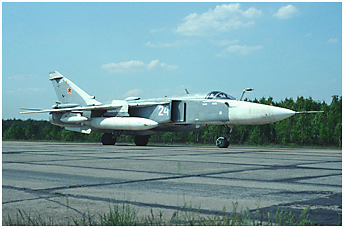 The first Su-24MR "Fencer-E" of the 11.ORAP flew their initial operational sorties from their Brandenburg base on February 17, 1986.
For a few weeks, the regiment's new reconnaissance aircraft flew alongside the Yak-28R that they were replacing. The last "Brewer-D" indeed
left Germany on July 2, 1986. Only two squadrons, entirely equipped with Su-24MR, remained at Welzow.
The first Su-24MR "Fencer-E" of the 11.ORAP flew their initial operational sorties from their Brandenburg base on February 17, 1986.
For a few weeks, the regiment's new reconnaissance aircraft flew alongside the Yak-28R that they were replacing. The last "Brewer-D" indeed
left Germany on July 2, 1986. Only two squadrons, entirely equipped with Su-24MR, remained at Welzow.
While the desire to develop a tactical reconnaissance version of the T-58M designated T-58MR dates back to the summer of 1965, the preliminary study was completed only in 1970.
The designation of the future "Fencer" had in the meantime changed from T-58M to T6. It was not until September 1980 that the T6MR (Product 48), designated Su-24MR in the VVS, made its first flight.
In total, more than 130 aircraft were built in Novisibirsk between 1983 and 1993.
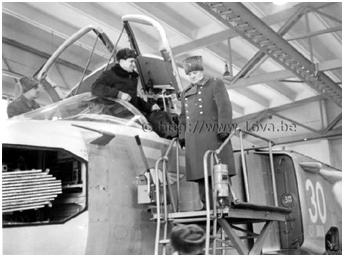
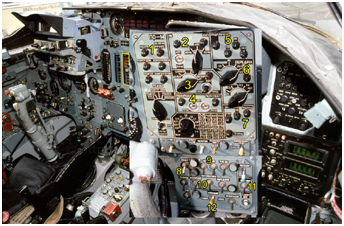 The Su-24MR (MR for Modifikatsirovanyy Razvedchik) was a conventional reconnaissance aircraft whose large size permitted it to carry
the BKR-1 airborne reconnaissance complex (Bortovim Kompleksom Razvedki). The reconnaissance systems of the BRK-1 suite, which included a wide range of conventional, infrared and electronic reconnaissance means, made the Su-24MR a much more capable reconnaissance platform than its predecessors, namely the MiG-21R, Yak-28R and Su-17M3R/-M4R.
It fulfilled a so-called operational reconnaissance role, while the Su-17M3R of the 294.ORAP operated on a tactical level.
A M-101 Shtik (Bayonet) Side Looking Airborne Radar (SLAR) was mounted inside its nose in lieu of the Orion radar mounted in the Su-24M.
The SLAR resolution ranged from 5 to 7.5 meters, allowing day and night visual or electronic observation of an area of 4 to 28 kilometers wide on each side of the aircraft, alternately.
The extension of the white paint behind the nose radome was a ruse to hide the large lateral dielectric panels of the SLAR.
The Su-24MR (MR for Modifikatsirovanyy Razvedchik) was a conventional reconnaissance aircraft whose large size permitted it to carry
the BKR-1 airborne reconnaissance complex (Bortovim Kompleksom Razvedki). The reconnaissance systems of the BRK-1 suite, which included a wide range of conventional, infrared and electronic reconnaissance means, made the Su-24MR a much more capable reconnaissance platform than its predecessors, namely the MiG-21R, Yak-28R and Su-17M3R/-M4R.
It fulfilled a so-called operational reconnaissance role, while the Su-17M3R of the 294.ORAP operated on a tactical level.
A M-101 Shtik (Bayonet) Side Looking Airborne Radar (SLAR) was mounted inside its nose in lieu of the Orion radar mounted in the Su-24M.
The SLAR resolution ranged from 5 to 7.5 meters, allowing day and night visual or electronic observation of an area of 4 to 28 kilometers wide on each side of the aircraft, alternately.
The extension of the white paint behind the nose radome was a ruse to hide the large lateral dielectric panels of the SLAR.
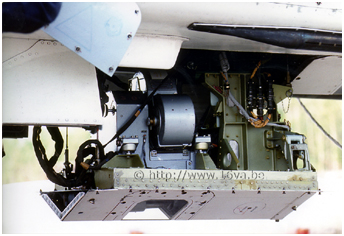
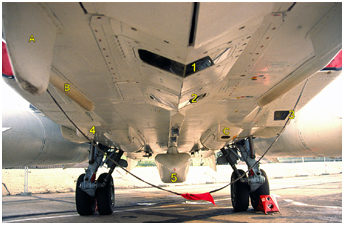 The Kadr (Frame) complex included an AP-402M (> Link) rotary prism-equipped panoramic camera with a focal length of 90.5 mm
located under the fuselage right behind the nose wheel where the Kaira-24 system was installed on the Su-24M.
If necessary, the photos stored in a parachute-equipped cassette could be jettisoned in flight. Since examining detailed photographs or information does not give any clue, we assume that the release hatch was hidden in the housing of the airbrakes which would then have had to be extended to drop the cassettes.
A second camera completed the Kadr system. It was an A-100 oblique camera with a focal length of 1000 mm mounted under the left reactor air intake.
An Aist-M (Stork) TV reconnaisssance system also found its place inside the
fuselage, just behind the AP-402M camera. Finally, the Zima (Winter) IR sensor formed a small fairing that could be found set back under the right engine air intake.
A data link was used to transmit the images collected by TV, IR and laser means to a ground station. The aircraft position and the time also were recorded for each picture taken.
The digital data were received and analyzed with the Posrednik (Intermediary) mobile complex mounted on two trucks.
The Kadr (Frame) complex included an AP-402M (> Link) rotary prism-equipped panoramic camera with a focal length of 90.5 mm
located under the fuselage right behind the nose wheel where the Kaira-24 system was installed on the Su-24M.
If necessary, the photos stored in a parachute-equipped cassette could be jettisoned in flight. Since examining detailed photographs or information does not give any clue, we assume that the release hatch was hidden in the housing of the airbrakes which would then have had to be extended to drop the cassettes.
A second camera completed the Kadr system. It was an A-100 oblique camera with a focal length of 1000 mm mounted under the left reactor air intake.
An Aist-M (Stork) TV reconnaisssance system also found its place inside the
fuselage, just behind the AP-402M camera. Finally, the Zima (Winter) IR sensor formed a small fairing that could be found set back under the right engine air intake.
A data link was used to transmit the images collected by TV, IR and laser means to a ground station. The aircraft position and the time also were recorded for each picture taken.
The digital data were received and analyzed with the Posrednik (Intermediary) mobile complex mounted on two trucks.
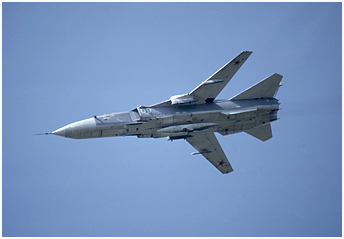
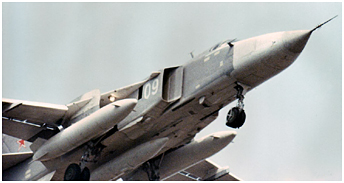 The Su-24MR had on its back a large air scoop feeding a heat exchanger to cool the onboard systems it carried, like with the other "Fencer" versions.
However, the one of the "Fencer-E" seemed larger due to its rounded top fairing. The latter housed the antenna of the ShRK-1 large band data link transmitter.
The Su-24MR had no offensive capability and the Orion-A attack radar, the Kayra-24 weapons system and the GSh-6-23M cannon that the "Fencer-D" attack aircraft carried
were not mounted.
In order to ensure its survival, the Su-24MR was equipped with the remarkable BKO-2M Karpaty self-defense suite of the Su-24M that included on the late production batches
a SPO-15M Bereza (Birch) radar warning and homing radar receiver, a L082 Mak-UL (Poppy) IR missile detector,
a SPS-161/162 Geran-F (Geranium) radar jamming system and APP-50A flare launchers. The whole complex was under the control of a Neon-F digital computer.
The "Fencer-F" were wired to carry R-60 or R-60M (AA-8 "Aphid") short-range IR air to air missiles under their wings.
The 11.ORAP aircraft often were observed with APU-60-2 adapters for two R-60 missiles under the left wing outboard pylon.
The Rel'yef terrain-following radar was still mounted in the radome, giving the "Fencer-F" low-altitude penetration capabilities.
The Su-24MR had on its back a large air scoop feeding a heat exchanger to cool the onboard systems it carried, like with the other "Fencer" versions.
However, the one of the "Fencer-E" seemed larger due to its rounded top fairing. The latter housed the antenna of the ShRK-1 large band data link transmitter.
The Su-24MR had no offensive capability and the Orion-A attack radar, the Kayra-24 weapons system and the GSh-6-23M cannon that the "Fencer-D" attack aircraft carried
were not mounted.
In order to ensure its survival, the Su-24MR was equipped with the remarkable BKO-2M Karpaty self-defense suite of the Su-24M that included on the late production batches
a SPO-15M Bereza (Birch) radar warning and homing radar receiver, a L082 Mak-UL (Poppy) IR missile detector,
a SPS-161/162 Geran-F (Geranium) radar jamming system and APP-50A flare launchers. The whole complex was under the control of a Neon-F digital computer.
The "Fencer-F" were wired to carry R-60 or R-60M (AA-8 "Aphid") short-range IR air to air missiles under their wings.
The 11.ORAP aircraft often were observed with APU-60-2 adapters for two R-60 missiles under the left wing outboard pylon.
The Rel'yef terrain-following radar was still mounted in the radome, giving the "Fencer-F" low-altitude penetration capabilities.
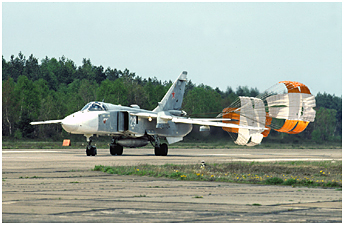
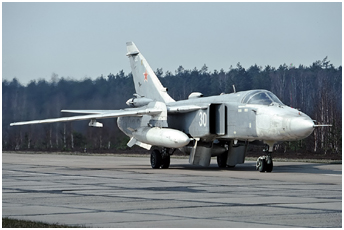 As part of their mission and in addition to their standard onboard equipment, the Su-24MR of Welzow always carried one or two specialized pods.
The Konteyner n°1 was a Shpil'-2M (Spire) (> Link) laser designed for
low-level reconnaissance, mounted under the forward fuselage hardpoint.
The images collected from an altitude of 400 meters were almost of photographic quality thanks to a 25 cm resolution.
The laser system that could be used both by day and night could cover a strip of land with a width equal to four times
the aircraft altitude. The data collected were transmitted to the ground in real time with the data link.
Konteyner n°2 was a SRS-14 Tangazh (Pitch) SIGINT pod (> Link)
mounted under the rear fuselage hardpoint.
It was designed to detect, determine the coordinates, type and operating mode of the enemy radars.
Konteyner n°3 M-341 Efir-1M (Ether) was attached exclusively under the right wing. It was designed for measuring the levels
of radioactivity in the air. The data were recorded on magnetic tapes or transmitted to the ground via the data link liaison.
Other external stores often observed at Welzow were the impressive 3000-liter PTB-3000 drop tanks to enable the "Fencers" to carry out long-range reconnaissance flights,
up to 400 km from the front line. They were always present on the flight line, often resting on wooden brackets.
As part of their mission and in addition to their standard onboard equipment, the Su-24MR of Welzow always carried one or two specialized pods.
The Konteyner n°1 was a Shpil'-2M (Spire) (> Link) laser designed for
low-level reconnaissance, mounted under the forward fuselage hardpoint.
The images collected from an altitude of 400 meters were almost of photographic quality thanks to a 25 cm resolution.
The laser system that could be used both by day and night could cover a strip of land with a width equal to four times
the aircraft altitude. The data collected were transmitted to the ground in real time with the data link.
Konteyner n°2 was a SRS-14 Tangazh (Pitch) SIGINT pod (> Link)
mounted under the rear fuselage hardpoint.
It was designed to detect, determine the coordinates, type and operating mode of the enemy radars.
Konteyner n°3 M-341 Efir-1M (Ether) was attached exclusively under the right wing. It was designed for measuring the levels
of radioactivity in the air. The data were recorded on magnetic tapes or transmitted to the ground via the data link liaison.
Other external stores often observed at Welzow were the impressive 3000-liter PTB-3000 drop tanks to enable the "Fencers" to carry out long-range reconnaissance flights,
up to 400 km from the front line. They were always present on the flight line, often resting on wooden brackets.
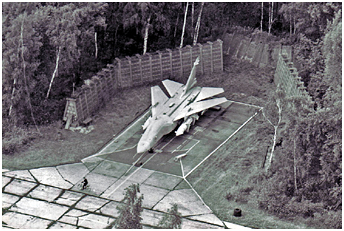
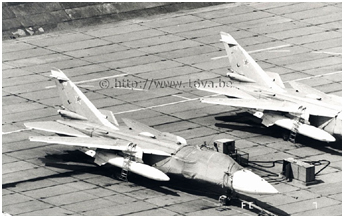 The "Fencer" of the 11.ORAP had a particular feature that they only shared - within the 16.VA - with the Su-24 of the 497.BAP of Grossenhain and the Su-24M of the 116.GBAP from Brand.
It was a retractable in-flight refueling boom that was centered in front of the windscreen.
However, unlike the aircraft of the 116.GBAP that used UPAZ-1A Sakhalin in-flight refueling pods (> Link),
the Su-24MR did not practiced in-flight refueling using the "buddy-buddy" technique between them. The "Fencer-F" indeed always carried a reconnaissance pod
under its belly and consequently were not equipped to carry a Sakhalin refueling pod.
The "Fencer" of the 11.ORAP had a particular feature that they only shared - within the 16.VA - with the Su-24 of the 497.BAP of Grossenhain and the Su-24M of the 116.GBAP from Brand.
It was a retractable in-flight refueling boom that was centered in front of the windscreen.
However, unlike the aircraft of the 116.GBAP that used UPAZ-1A Sakhalin in-flight refueling pods (> Link),
the Su-24MR did not practiced in-flight refueling using the "buddy-buddy" technique between them. The "Fencer-F" indeed always carried a reconnaissance pod
under its belly and consequently were not equipped to carry a Sakhalin refueling pod.
| ORBAT 1945 - 1993 |
Electronic warfare
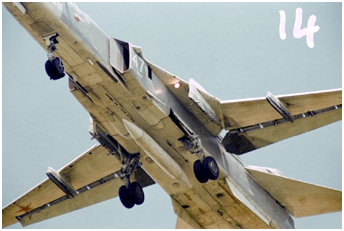
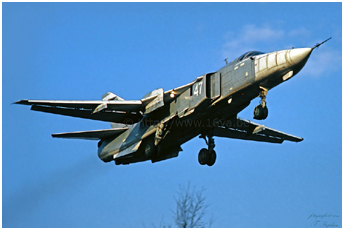 The third squadron of the 11.ORAP lost its Yak-28PP electronic warfare aircraft in 1986 when they were transferred to the second squadron of the 931.OGRAP.
However, the 3.AE was back in 1989 when it received all the operational
Su-24MP "Fencer-F" i.e. eight aircraft. They were therefore the only aircraft of this type deployed outside the territory of the USSR.
The Su-24MP (MP for Modifikatsirovanyy Postanovshchik-Pomekh - Modified Jammer) - sometimes compared to the US EF-111 "Raven"
- was expected to become the successor of the Yak-28PP within the VVS. The latter had been kept in service for a long time for lack of a replacement and could
no longer claim to provide protection for Su-24 attack formations. Two Su-24M were modified to serve as a test bench and the first aircraft transformed with electronic
warfare equipment designated T-6MP-25 first flew on March 14, 1980, four months before the first Su-24MR prototype. In addition to the two prototypes,
production of the T-6MP alias "Article 46" or Su-24MP, was carried out in Novosibirsk from 1983 in parallel with that of the T-6MR alias "Article 48" or Su-24MR. This was limited to
only 10 aircraft. Two of them were transferred to the Lipetsk Operational Conversion Center, while the others joined the Yak-28PP of 118.OAPREB (Otde'lniy Aviatsionnyy Polk
Radioelektronnoy Borb'i - Independent Electronic Warfare Aviation Regiment) at Chortkov in the Ukrainian SSR before finally being transferred to Welzow.
The third squadron of the 11.ORAP lost its Yak-28PP electronic warfare aircraft in 1986 when they were transferred to the second squadron of the 931.OGRAP.
However, the 3.AE was back in 1989 when it received all the operational
Su-24MP "Fencer-F" i.e. eight aircraft. They were therefore the only aircraft of this type deployed outside the territory of the USSR.
The Su-24MP (MP for Modifikatsirovanyy Postanovshchik-Pomekh - Modified Jammer) - sometimes compared to the US EF-111 "Raven"
- was expected to become the successor of the Yak-28PP within the VVS. The latter had been kept in service for a long time for lack of a replacement and could
no longer claim to provide protection for Su-24 attack formations. Two Su-24M were modified to serve as a test bench and the first aircraft transformed with electronic
warfare equipment designated T-6MP-25 first flew on March 14, 1980, four months before the first Su-24MR prototype. In addition to the two prototypes,
production of the T-6MP alias "Article 46" or Su-24MP, was carried out in Novosibirsk from 1983 in parallel with that of the T-6MR alias "Article 48" or Su-24MR. This was limited to
only 10 aircraft. Two of them were transferred to the Lipetsk Operational Conversion Center, while the others joined the Yak-28PP of 118.OAPREB (Otde'lniy Aviatsionnyy Polk
Radioelektronnoy Borb'i - Independent Electronic Warfare Aviation Regiment) at Chortkov in the Ukrainian SSR before finally being transferred to Welzow.
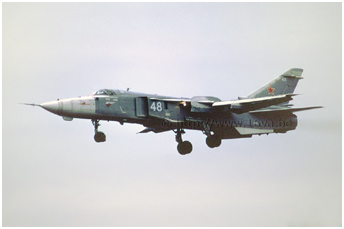
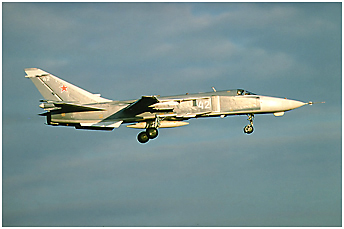 The Su-24MP could easily be distinguished from the other "Fencer" variants by a large rectangular antenna fairing placed under its nose radome and by the two hockey stick
shaped antennas of the SPS-5 Fasol' (Kidney Bean) jamming system located behind the engines air intakes as also was the case for the Yak-28PP.
The various on-board electronic countermeasure systems made up the Landysh (Lily of the Valley) suite.
Like the MR variant, the MP version had no Orion-A attack radar but kept the Rel'yef' terrain-following radar. Its nose also was painted white to hide the rectangular
dielectric panels of the jamming systems mounted inside the nose radome making them quite similar to common "Fencers."
The in-flight refueling boom was maintained, but not the ability to carry an UPAZ pod. On the other hand, the aircraft of the 11.ORAP regularly carried a ventral pod
resembling a Shpil'-2M pod. However, this was completely different equipment. The "Fencer-F" could carry two types of ventral pods
simply designated Konteyner n°1 and Konteyner n°2 in the manner of those of the Su-24MR. The first pod housed SPS-6 Los' (Moose) and Mimoza (Mimosa)
jammers while the second was an Avtomat-DU automatic decoy launcher designed to jam radars. The Landysh (Lily of the Valley) electronic warfare suite of the Su-24MP
needed larger cooling systems. These planes, alone or in formation, would have been responsible for jamming the enemy's air defense and research systems in order to clear the way for the bombers.
The second prototype was photographed with a full load of 100 kg bombs - but does that mean that the Su-24MP was to be employed as a bomber as well?
The Su-24MP could rely on the different systems common to the M and MR variants already described and R-60 missiles to ensure its survivability.
The Su-24MP could easily be distinguished from the other "Fencer" variants by a large rectangular antenna fairing placed under its nose radome and by the two hockey stick
shaped antennas of the SPS-5 Fasol' (Kidney Bean) jamming system located behind the engines air intakes as also was the case for the Yak-28PP.
The various on-board electronic countermeasure systems made up the Landysh (Lily of the Valley) suite.
Like the MR variant, the MP version had no Orion-A attack radar but kept the Rel'yef' terrain-following radar. Its nose also was painted white to hide the rectangular
dielectric panels of the jamming systems mounted inside the nose radome making them quite similar to common "Fencers."
The in-flight refueling boom was maintained, but not the ability to carry an UPAZ pod. On the other hand, the aircraft of the 11.ORAP regularly carried a ventral pod
resembling a Shpil'-2M pod. However, this was completely different equipment. The "Fencer-F" could carry two types of ventral pods
simply designated Konteyner n°1 and Konteyner n°2 in the manner of those of the Su-24MR. The first pod housed SPS-6 Los' (Moose) and Mimoza (Mimosa)
jammers while the second was an Avtomat-DU automatic decoy launcher designed to jam radars. The Landysh (Lily of the Valley) electronic warfare suite of the Su-24MP
needed larger cooling systems. These planes, alone or in formation, would have been responsible for jamming the enemy's air defense and research systems in order to clear the way for the bombers.
The second prototype was photographed with a full load of 100 kg bombs - but does that mean that the Su-24MP was to be employed as a bomber as well?
The Su-24MP could rely on the different systems common to the M and MR variants already described and R-60 missiles to ensure its survivability.
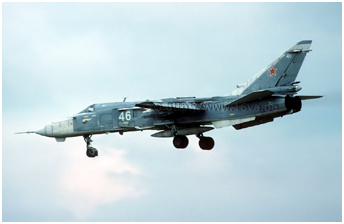
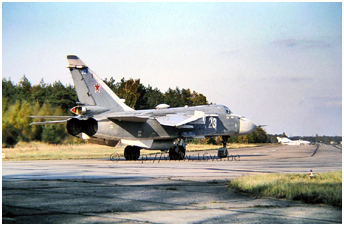 On June 5 and 7, 1991 the eight Su-24MP "Fencer-F" of the 11.ORAP flew back to Chortkov and joined again the 118.OAPREB
- then equipped with Yak-28PP, including some previously based at Welzow and repatriated from Werneuchen in 1989 (1).
A few days earlier, precisely on May 21, the last 16 MiG-25 reconnaissance aircraft of the 931.OGRAP had moved to Welzow where they became most certainly the third
squadron of the 11.ORAP. The last 16.VA "Foxbat" left Germany on 1 and 6 July, 1992 for Shatalovo.
One year later, on June 15, 1993 the last two squadrons of the 11.ORAP moved their twenty-four Su-24MR to Marinovka, west of Volgograd (the former
Stalingrad) in the Russian North Caucasus Military District, where a few months later they were subordinated along with the 296.BAP (ex-296.APIB from Grossenhain)
to the new Russian 4.VA at Rostov-on-Don.
As a consequence of the VVS reorganization in 2009, the former 11.ORAP still based in Marinovka became a component of the 6970th Air Base, alongside two Su-24M squadrons of the former 559.BAP (ex-559.APIB of Finsterwalde) based in Morozovsk. A year later, its aircraft grouped into a reconnaissance aviation squadron were integrated into the 6972nd Guards Air Base. In December 2015, the 11th Composite Aviation Regiment (SAP) was established with a squadron of Su-24M redeployed from Morozovsk and a reconnaissance squadron.
On June 5 and 7, 1991 the eight Su-24MP "Fencer-F" of the 11.ORAP flew back to Chortkov and joined again the 118.OAPREB
- then equipped with Yak-28PP, including some previously based at Welzow and repatriated from Werneuchen in 1989 (1).
A few days earlier, precisely on May 21, the last 16 MiG-25 reconnaissance aircraft of the 931.OGRAP had moved to Welzow where they became most certainly the third
squadron of the 11.ORAP. The last 16.VA "Foxbat" left Germany on 1 and 6 July, 1992 for Shatalovo.
One year later, on June 15, 1993 the last two squadrons of the 11.ORAP moved their twenty-four Su-24MR to Marinovka, west of Volgograd (the former
Stalingrad) in the Russian North Caucasus Military District, where a few months later they were subordinated along with the 296.BAP (ex-296.APIB from Grossenhain)
to the new Russian 4.VA at Rostov-on-Don.
As a consequence of the VVS reorganization in 2009, the former 11.ORAP still based in Marinovka became a component of the 6970th Air Base, alongside two Su-24M squadrons of the former 559.BAP (ex-559.APIB of Finsterwalde) based in Morozovsk. A year later, its aircraft grouped into a reconnaissance aviation squadron were integrated into the 6972nd Guards Air Base. In December 2015, the 11th Composite Aviation Regiment (SAP) was established with a squadron of Su-24M redeployed from Morozovsk and a reconnaissance squadron.
notes
(1)
Six aircraft would have remained operational with the 118.OAPREB, while two aircraft would have joined the 4.TsBP i PLS (Tsenter Boevoy
Podgotovki i Pereuchivaniya Letnogo Sostava - Combat Training and Flight Personnel Conversion Center) at Lipetsk. The six aircraft became
Ukrainian after the dissolution of the USSR and they would have finished their careers stored at the Nikolayev Aviation Repair Plant (ARZ).
 |
Su-24MR/MP PHOTO PAGE |  |
 | Su-24MP & MR at Welzow |  |
 |
11.ORAP < Part 1 |
 |
Plan du site - Sitemap |  |

